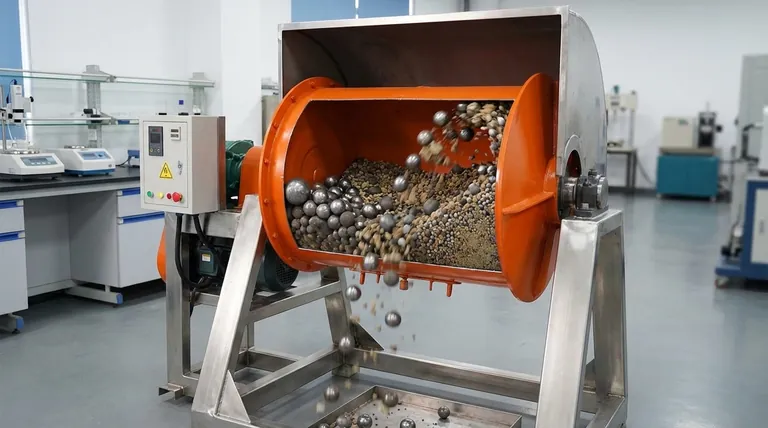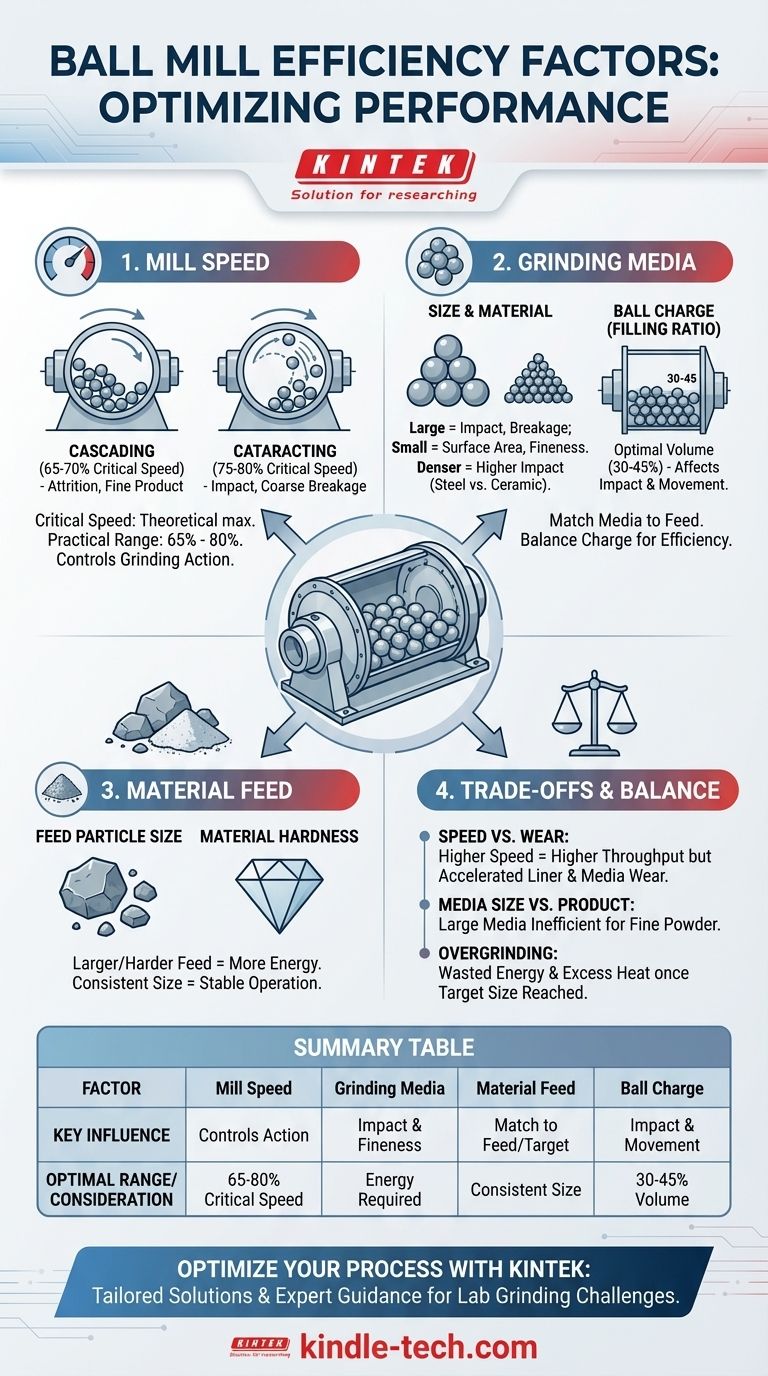Understanding the efficiency of a ball mill is a matter of managing four interconnected variables. The primary factors that dictate grinding performance are the rotational speed of the mill, the characteristics of the grinding media (the balls), the properties of the material being ground, and the volume percentage of the mill filled with media, known as the filling ratio.
The core challenge in ball milling is not maximizing any single factor, but achieving a precise balance between them. True efficiency comes from creating the optimal grinding action for a specific material, which minimizes energy consumption and processing time.

The Critical Role of Mill Speed
The speed at which the mill rotates directly controls the behavior of the grinding media and, therefore, the entire grinding mechanism. It's the most influential operational parameter.
The Concept of Critical Speed
Critical speed is the theoretical rotational speed at which the outermost layer of grinding balls will centrifuge, meaning they cling to the mill's inner wall due to centrifugal force. Operating at or above this speed results in little to no grinding.
Practical operating speeds are always a percentage of this critical speed, typically between 65% and 80%.
Optimizing for Grinding Action
Slight adjustments in speed within this operating range create vastly different grinding actions.
- Cascading: At lower speeds, the balls tumble over one another in a cascading motion. This creates grinding through attrition (friction) and is ideal for producing a very fine product.
- Cataracting: At higher speeds, the balls are thrown across the mill, creating a "cataracting" motion. This emphasizes grinding through impact, which is more effective for breaking down coarser feed particles quickly.
Characteristics of the Grinding Media
The balls inside the mill are the tools that perform the work. Their size, material, and quantity are fundamental to the process.
Media Size and Its Impact
The size of the grinding media must be matched to the size of the material being ground. Larger, heavier balls are necessary to break large feed particles, while smaller balls have more surface area and are more efficient at grinding material down to a fine powder.
Media Material and Density
Grinding media is typically made from steel, ceramic, or flint pebbles. Denser media, like steel, provides a much higher impact force and is suitable for hard materials. Lighter ceramic media may be used when product contamination from steel is a concern.
Ball Charge (Filling Ratio)
The ball charge is the percentage of the mill's internal volume occupied by the grinding media. This is typically between 30% and 45%.
Too low a charge results in insufficient grinding impacts. Too high a charge restricts the movement of the media, dampening its action and reducing overall efficiency.
Properties of the Material Feed
The material you put into the mill determines the energy and time required to achieve the desired result.
Feed Particle Size
The larger the initial feed particles relative to the desired final product size, the more work the mill has to do. A consistent feed size allows for a more stable and predictable grinding operation.
Material Hardness
Harder materials naturally require more energy and time to break down. This may necessitate the use of denser grinding media (like forged steel) and can lead to higher rates of media and liner wear.
Understanding the Trade-offs
Optimizing a ball mill is an exercise in balancing competing factors. Pushing one variable to its extreme often creates a negative consequence elsewhere.
Speed vs. Wear
Increasing mill speed can increase throughput, but it comes at a significant cost. Higher speeds dramatically accelerate the wear on both the grinding media and the mill's internal liner, leading to higher maintenance costs and downtime.
Media Size vs. Final Product
Using large media is very efficient for the initial stage of breaking down coarse material. However, those same large balls are highly inefficient at producing a fine powder because they have limited surface area and create fewer impact points.
Overgrinding and Energy Waste
Once the material has reached the target particle size, any further operation is wasted energy. Overgrinding does not improve the product; it only consumes power, generates excess heat, and contributes to unnecessary wear on the equipment.
Optimizing Your Grinding Process
Your specific goal should dictate how you balance these variables.
- If your primary focus is breaking down a coarse feed: Use larger, denser grinding media and operate at a higher percentage of critical speed (e.g., 75-80%) to promote high-impact cataracting action.
- If your primary focus is producing a very fine powder: Use a charge of smaller grinding media to maximize surface area and run at a lower speed (e.g., 65-70% of critical) to encourage a cascading, attrition-based grinding action.
- If your primary focus is maximizing energy efficiency: Carefully match your media size and ball charge to the specific feed material and establish a precise run time to prevent wasteful overgrinding.
Mastering these variables transforms ball milling from a brute-force process into a precisely controlled engineering operation.
Summary Table:
| Factor | Key Influence | Optimal Range/Consideration |
|---|---|---|
| Mill Speed | Controls grinding action (cascading vs. cataracting) | 65% - 80% of critical speed |
| Grinding Media | Size, material, and density dictate impact force and fineness | Match size/material to feed hardness and target particle size |
| Material Feed | Hardness and initial particle size determine energy required | Consistent feed size for stable operation |
| Ball Charge (Filling Ratio) | Volume of media affects grinding impact and media movement | Typically 30% - 45% of mill volume |
Struggling to achieve the right particle size or reduce energy costs in your lab? The experts at KINTEK are here to help. We specialize in lab equipment and consumables, providing tailored solutions for your specific grinding challenges. Whether you need guidance on optimizing your ball mill parameters or selecting the right grinding media for your materials, our team can help you maximize efficiency and throughput. Contact KINTEL today for a personalized consultation and let us help you perfect your grinding process!
Visual Guide

Related Products
- Stainless Steel Laboratory Ball Mill for Dry Powder and Liquid with Ceramic Polyurethane Lining
- Laboratory Jar Ball Mill with Alumina Zirconia Grinding Jar and Balls
- Laboratory Ball Mill Jar Mill with Metal Alloy Grinding Jar and Balls
- Laboratory Single Horizontal Jar Mill
- Laboratory Planetary Ball Mill Rotating Ball Milling Machine
People Also Ask
- What is the theory of ball milling? Mastering Particle Size Reduction Through Impact and Attrition
- What is the purpose of ball milling? A Versatile Tool for Material Synthesis and Modification
- What are the disadvantages of a ball mill? High Energy Use, Noise, and Contamination Risks
- What is the difference between a ball mill and a sag mill? A Guide to Primary vs. Secondary Grinding
- What are the main components of a ball mill? Optimize Your Grinding Process for Peak Performance



















